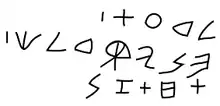_LR_0168_(cropped).jpg.webp)

_LR_0170_(cropped).jpg.webp)
The Byblos Necropolis graffito is a Phoenician inscription situated in the Royal necropolis of Byblos.
The graffito of Ahiram's tomb was found on the south wall of the shaft leading to the hypogeum, about three meters from the opening.
The three-line graffito with William F. Albright's translation:[2]
| (1) | 𐤋𐤃𐤏𐤕 | ld‘t | Attention! |
| (2) | 𐤄𐤍 𐤉𐤐𐤃 𐤋𐤊 | hn ypd lk | Behold, thou shalt come to grieve |
| (3) | 𐤕𐤇𐤕 𐤆𐤍 | tḥt zn | below here![3] |
René Dussaud, who found the text, translated it as "Avis, voici ta perte (est) ci-dessous" ("Beware, here is your loss (is) below").
The fourth sign of the second line (now considered to be a pē), is not very clear, a bēt seems to have been engraved on top of a qōp, or vice versa.
Pierre Montet, the archaeologist who excavated the royal necropolis 1922, made the following comment:
Since the graffiti is a little higher than the niches on the east and west walls, it is easy to understand why this notice was engraved here. The beams that rested in the niches supported a floor spanning the width of the shaft. The builders of the tomb did not consider that the king's corpse was sufficiently protected by the paving of the opening and by the wall built at the entrance to the chamber halfway up the well, so they laid a floor of wood which acted as a third obstacle. The looters, who would have removed the paving and started to empty the well, could not have avoided seeing the notice once they reached this floor.[4]
Bibliography
- Vincent, L. H. (1925). "Les fouilles de Byblos" [The excavations of Byblos]. Revue Biblique (1892-1940) (in French). 34 (2): 161–193. ISSN 1240-3032.
References
- ↑ Vincent 1925, PLANCHE VIII.
- ↑ Donner, Herbert; Rölig, Wolfgang (2002). Kanaanäische und aramäische Inschriften (5 ed.). Wiesbaden: Harrassowitz. p. I, 1.
- ↑ Albright, W.F. (1947). "The Phoenician inscriptions of the tenth century B.C. from Byblus". Journal of the American Oriental Society. 67 (3): 153-160: p. 156. Retrieved 2022-04-26.
- ↑ Montet, Byblos et l'Égypte, p. 217: "Si l’on remarque que le graffite est un peu plus haut que les niches des parois est et ouest, on n’a pas de peine à comprendre pourquoi cet avis a été gravé à une telle place. Les poutres qui s’appuyaient dans les niches soutenaient un plancher tenant toutes la largeur du puits. Les constructeurs du tombeau n’ont pas estimé que le cadavre du roi fût suffisamment protégé par le dallage de l’orifice et par le mur bâti à l’entrée de la chambre à mi-hauteur du puits, ils ont donc posé un plancher de bois qui constituait un troisième obstacle. Les pillards qui auraient enlevé le dallage et commencé à vider le puits, n’auraient pu éviter d’apercevoir l’avis une fois parvenus à ce plancher."